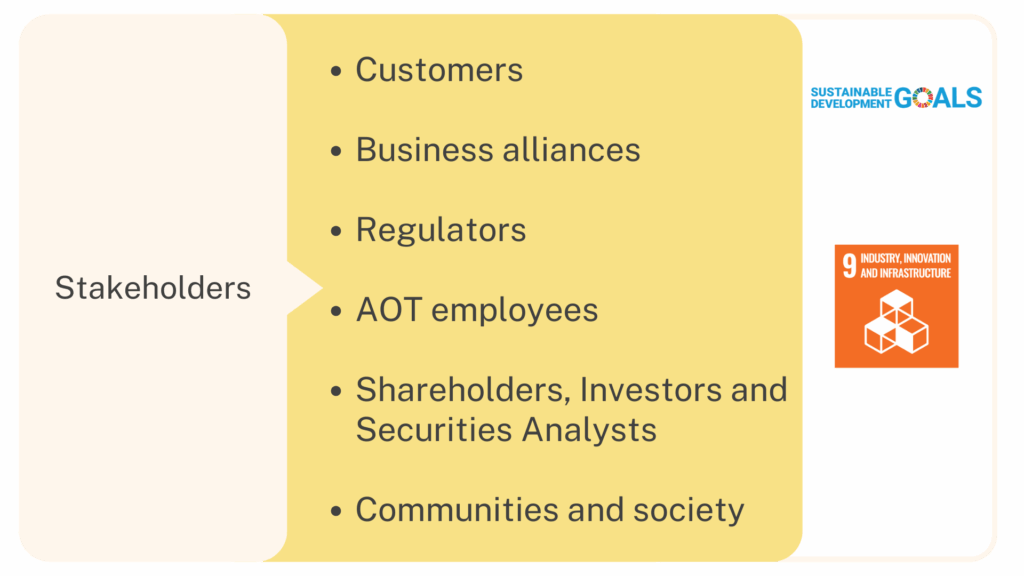
Importance
The development of AOT’s operations through digital technology and innovation in airport management plays a vital role in enhancing the organization’s overall competitiveness. This includes improving internal management, elevating service quality, and creating a seamless and satisfying airport experience for airlines, business operators, and passengers. It also contributes to attracting new business partners and increasing operational efficiency across AOT departments.
Examples include the implementation of Automated Passport Control systems, which accelerate passport verification processes and alleviate airport congestion; biometric authentication to strengthen safety assurance for operational partners; and the development of Digital Office systems to enhance workplace convenience for AOT personnel.
Furthermore, digital technology and innovation contribute significantly to improving communication and collaboration among departments through faster and more accurate data support. They also enhance information security through integrated digital systems and innovative solutions.
Policy
AOT continues to build upon its innovation framework by advancing the policy introduced in 2023 to promote creativity and innovation management. The policy has been reviewed and refined for application in fiscal year 2025, aligning with the State Enterprise Assessment Model (SE-AM) of the State Enterprise Policy Office to ensure a comprehensive approach across all dimensions. The AOT Board of Directors has officially approved the “Policy on the Promotion of Creativity and Innovation Management,” and the Chairman of the Board has signed the policy as a declaration of AOT’s commitment to transitioning into a digital era for the benefit of society, the economy, and the environment. Key components of the policy include:
- Empowering personnel with creative thinking skills to drive innovation within the organization, with a focus on AOT’s Innovation Themes as outlined in the revised AOT Innovation Master Plan (Fiscal Year 2023–2027).
- Assigning responsibility for innovation advancement to all departments across the organization.
- Supporting the integration of knowledge, knowledge management (KM), scientific research, and digital technology into innovation development to address challenges, enhance services, and improve operational efficiency.
- Promoting the practical application of innovation in airport operations and development, including its commercial and social benefits.
- Prioritizing knowledge management (KM) as a foundation for innovation, encouraging the dissemination and application of knowledge, and fostering an Innovation Management (IM) system to support execution, monitoring, evaluation, and reporting.
- Fostering a culture of creativity and cultivating an innovation-driven organizational environment.
- Providing sufficient and appropriate funding and resources to support innovation projects.
Management Approach
AOT has integrated innovation into its core values, which are continuously upheld and developed across the organization. With a firm commitment to leveraging information technology as a key driver, AOT aims to become the world’s smartest airport, fostering innovation to achieve world-class excellence, generate balanced revenue opportunities, and deliver sustainable value to Thailand’s economy and society.
To this end, AOT has developed a Digital Technology and Innovation Master Plan aligned with its Corporate Plan, with the Digital Technology and Innovation Department serving as the primary responsible unit.
The guiding frameworks include:
Under Strategic Goal 5: Enhance service processes and quality to improve operational efficiency and stakeholder satisfaction, AOT emphasizes the role of technology and innovation through Strategy 5.2, which aims to drive the adoption of technology to enhance user experience. Additionally, under Strategic Goal 7: Strengthen organizational management capabilities, AOT outlines Strategy 7.2, focusing on improving work processes to increase efficiency and advance digital transformation. This includes enhancing customer experience through the adoption of modern technologies, developing workforce capabilities, streamlining operational processes, and implementing supportive tools to ensure the organization is well-prepared to support both core operations and future business opportunities.
| KPI | Performance | Annual Target | |||
|---|---|---|---|---|---|
| 2024 | 2025 | 2026 | 2027 | ||
| Strategy 5.2: Drive the adoption of technology to enhance user experience | |||||
| 1. Percentage of passengers utilizing installed technologies (%) | |||||
| 1.1 Common Use Self-Service (CUSS) Check-in System | |||||
| - Suvarnabhumi Airport | 27 | ≥25 | ≥25 | ≥25 | ≥25 |
| - Don Mueang International Airport | 20 | 18 | 20 | 22 | ≥25 |
| - Chiang Mai International Airport | 12.23 | 18 | 20 | 22 | ≥25 |
| 1.2 Common Use Bag Drop (CUBD) System | |||||
| - Suvarnabhumi Airport | 18.39 | 12 | 17 | 22 | ≥25 |
| Strategy 7.2: Improve work processes to enhance efficiency and advance toward digital transformation | |||||
| 1. Percentage of achievement in implementing the AOT Digital Roadmap | Incorporated into the Action Plan for Fiscal Year 2025 | 100 | 100 | 100 | 100 |
| 2. Percentage of achievement in implementing AOT’s Innovation Master Plan | Incorporated into the Action Plan for Fiscal Year 2025 | 100 | 100 | 100 | 100 |
AOT Innovation Master Plan (Fiscal Years 2023–2027, Revised in FY2024)
Recognizing the potential of innovation as a key driver for future organizational growth, AOT developed a scenario-based strategic plan through Scenario Planning using insights from diverse experts. This process aimed to identify key Innovation Themes, such as potential new businesses and targeted innovation within specific processes to enhance passenger satisfaction. The envisioned scenarios were then used to assess AOT’s organizational readiness, forming the basis for designing a suitable Corporate Innovation System.
Future Scenario Study
AOT adopted Foresight methodologies based on the STEEP framework—comprising Social, Technological, Economic, Environmental, and Political dimensions—to prioritize and define innovation themes. This framework aligns with emerging trends and helps anticipate risks and opportunities, supporting the organization’s long-term innovation direction.

Innovation Development in Accordance with the State Enterprise Assessment Framework
The development of innovation governance and management within the organization must be aligned with the State Enterprise Assessment Model (SE-AM), the national performance evaluation framework for state enterprises administered by the State Enterprise Policy Office (SEPO), Ministry of Finance. The model emphasizes a holistic view of the corporate innovation system, encompassing seven key dimensions:
- Leadership for sustainable innovation management
- Innovation strategy
- Customer- and market-driven innovation
- Knowledge-based innovation
- Innovation-focused culture
- Innovation processes
- Innovation results
The analysis of AOT’s innovation readiness has helped identify areas for improvement, as well as opportunities and gaps in enhancing the organization’s innovation capabilities. Further details are available in the AOT Innovation Master Plan (Fiscal Years 2023–2027, Revised in FY2024).
The development of innovation and technology has been recognized as a key strategic priority that supports AOT’s broader operations, especially in light of the rapid shift to the digital era. Accordingly, the Innovation Master Plan has been designed to align with other master plans within AOT. This ensures coherence and integration across all strategic initiatives, reinforcing the organization’s commitment to collaborative and mutually supportive development across all operational dimensions.
Driving AOT’s Innovation and Digital Technology Systems
AOT promotes both digital technology and innovation in parallel, recognizing them as critical enablers for enhancing organizational efficiency through structured management. A key element in establishing a systematic innovation process is the development of a Corporate Innovation System, which fosters an innovative culture—a creative environment where both internal and external personnel are encouraged to express diverse ideas and take initiative in developing new solutions aligned with AOT’s strategic goals.
To support this, AOT has established relevant policies, action plans, and operational guidelines that actively encourage innovation and digital technology development.

With AOT’s integrated management framework for digital technology and innovation, the organization has outlined an approach that fosters mutual reinforcement between the two domains. The strategy aims to drive the organization’s transformation into both an Innovative Organization and a Digital Organization, while advancing data-driven operations supported by robust and efficient information systems across all departments and business levels. By integrating digital technologies and innovation into airport business operations, AOT enhances value creation through comprehensive services in key areas such as airport safety and security, customer experience, and airport quality enhancement in response to global trends.
Digital technology and innovation are also recognized as key enablers that unlock organizational potential, enabling AOT to explore new business opportunities and models.
However, the challenge lies not only in the adoption of technology itself. The knowledge, understanding, and adaptability of personnel, along with legacy practices, also pose significant challenges. Therefore, the organization must work to adapt both its workforce and operational processes to align with emerging technologies and innovations. In the initial stage, this includes the equalization of technology—ensuring the selection and application of tools that are appropriate to AOT’s specific context and operational needs.
To ensure effective and high-quality implementation of its strategies, AOT actively monitors the progress of digital technology and innovation management across departments. This is done through strategic-level performance indicators defined in the Innovation Master Plan and Digital Action Plan. Progress is regularly reported to senior executives, who review and determine additional measures to promote success in line with organizational goals.
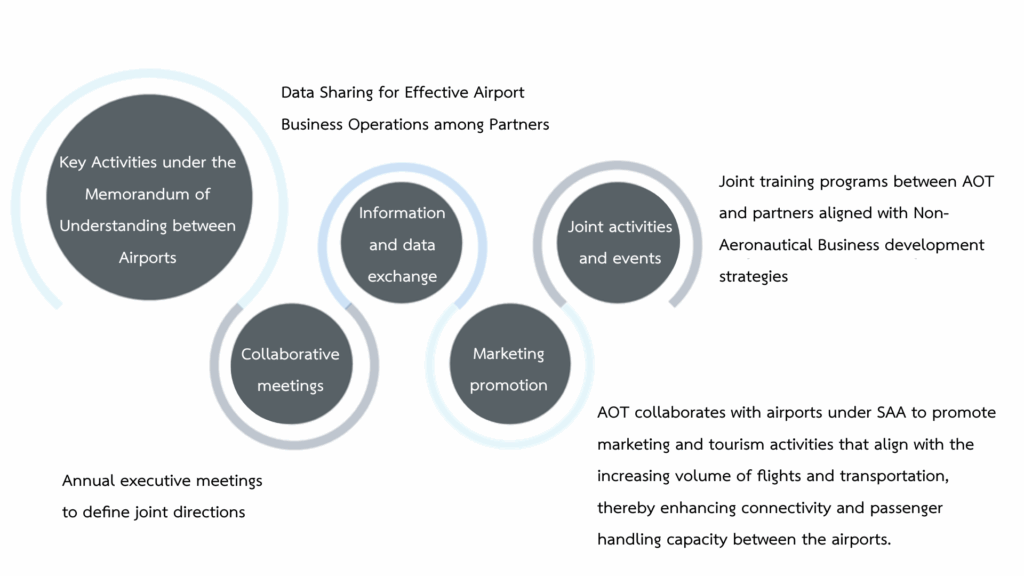
Driving Innovation to Create Value and New Business Opportunities at AOT
AOT has developed the AOT Innovation Management Manual, which compiles up-to-date knowledge on creativity and innovation management to serve as a practical guide for AOT personnel. The manual covers key topics including types and levels of innovation, creative idea generation processes, and fostering an innovation culture. It also outlines policies to support the organization’s transformation into an innovative enterprise through the Policy on the Promotion of Creativity and Innovation Management, which emphasizes innovation management across all areas of service, work processes, and new business/mission models at all organizational levels.
In this regard, AOT is committed to encouraging its personnel to apply creative thinking and innovation management throughout the organization. The policy includes 8 key components, which are designed to embed innovation into the organization’s core practices and culture.
Driving Innovation to Create Value and New Business Opportunities at AOT
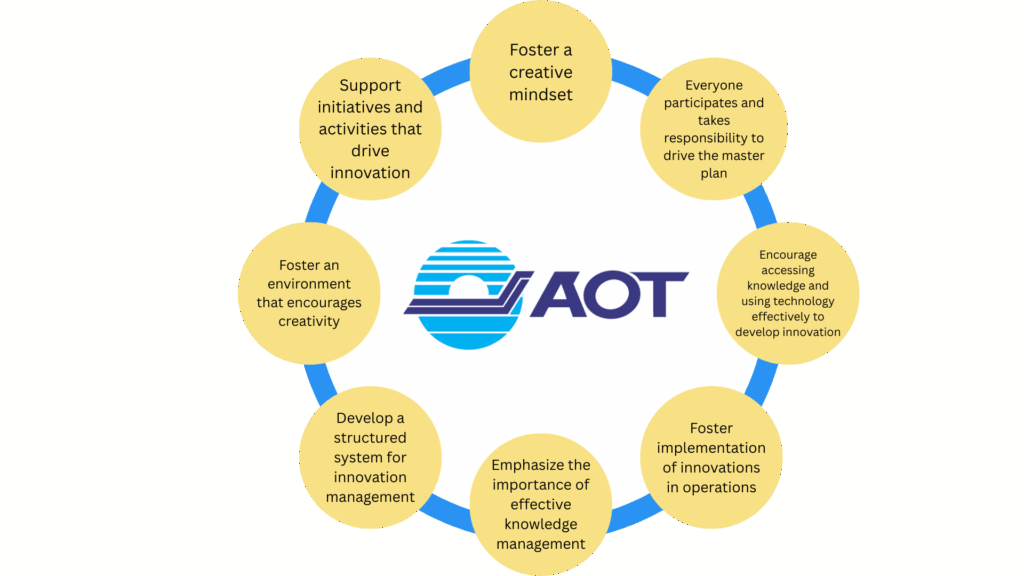
To support the organization’s effective transition toward becoming an innovative organization, AOT has incorporated this direction into Strategic Goal 4: Enhance non-aeronautical operations, with a particular focus on non-aeronautical business model innovation under Strategy 4.2, which emphasizes creating new business opportunities using AOT’s existing assets.
This includes developing new business model concepts and leveraging AOT’s assets to explore innovative opportunities—an area that AOT prioritizes as part of its innovation development agenda. To operationalize this direction, AOT has established a structured project-based innovation management framework, consisting of six key stages:

Digital Technology Integration
AOT has established an operational framework aimed at facilitating the organization’s transition toward digital transformation, in alignment with AOT’s unique context. This framework supports a transformation that is both effective and responsive to the expectations of all stakeholders in a comprehensive manner.
In addition, AOT’s digital transformation direction takes into account both national and global trends, ensuring that implementation and integration are harmonized with the organization’s ongoing operations. The organization is undergoing a holistic transformation to enhance its capabilities, modernize its infrastructure, and strengthen its competitiveness—driven by digital technology as a core enabler of success.
To achieve this, AOT must develop or adapt three fundamental factors essential to enabling digital transformation: 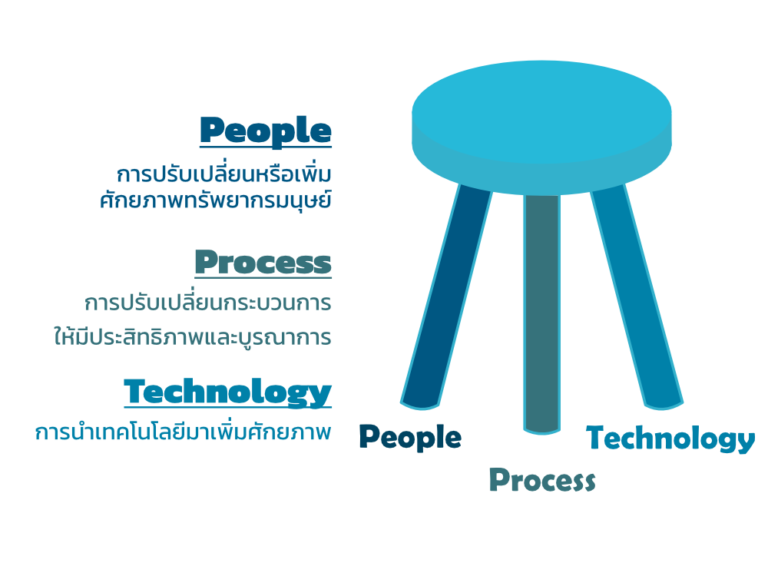
In addition, AOT’s organizational enhancement strategies—as outlined in the Digital Action Plan (Fiscal Years 2024–2027)—identify key focus areas that align with and support the organization’s digital transformation. These strategies comprehensively address the following four core areas:
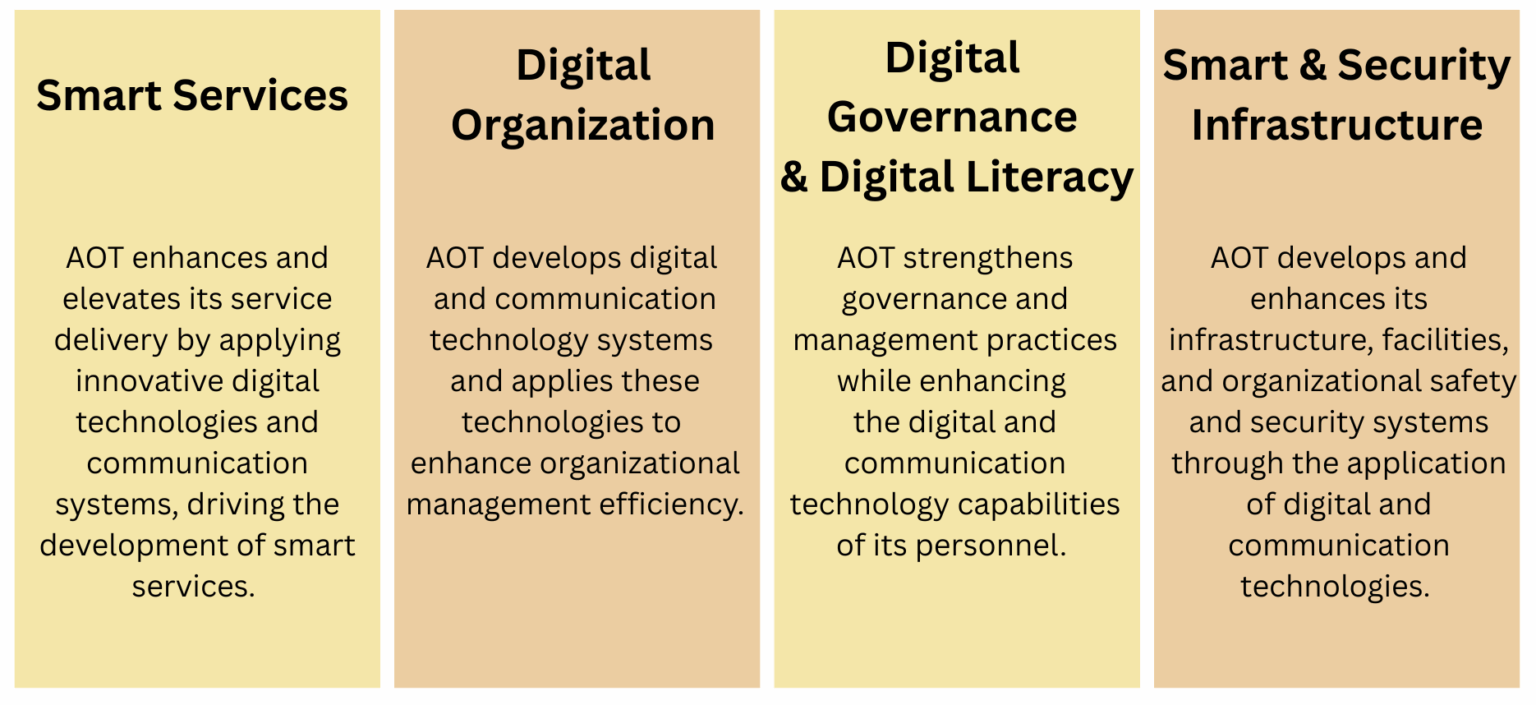
In transitioning toward a digital organization, AOT has established its approach based on the four strategic pillars outlined above. These strategies form the foundation of AOT’s digital implementation framework, aimed at achieving the goal of Smartest Airport Operation under the AOT Digital Roadmap 2024–2027. The four strategic areas serve as the core drivers in guiding the organization’s development in alignment with the planned focus areas.
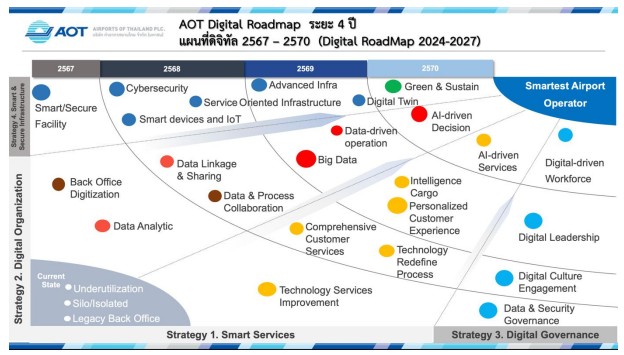
In integrating existing operations with digital technologies and new innovations, AOT ensures that implementation aligns with the expectations and needs of its relevant internal stakeholders. These include support for safety and security operations, corporate governance and board affairs, environmental initiatives under the Green Airport concept, and human resource development and management. All efforts are carried out within the framework of strategic plans and policies.
To maximize the effectiveness of digital and innovative tools, AOT has structured its initiatives into four key components: Digital Application (M1), Digital Operation (M2), Digital Office (M3), and Digital Cargo (M4). These four pillars serve as the foundation for transforming AOT into a digitally empowered organization, ensuring comprehensive attention to all critical aspects of its business operations.
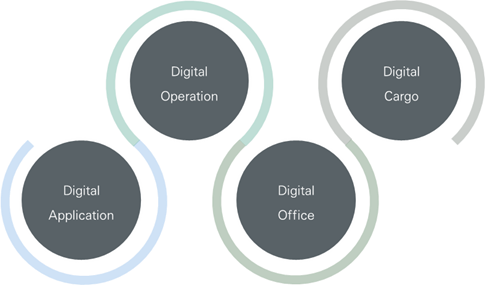
Digital Application (M1)
AOT has developed the “Sawasdee by AOT” application as a digital tool to connect passengers with airport services, enabling convenient and real-time access to essential information such as flight schedules, boarding gates, airport maps, and baggage claim areas. The app also facilitates access to information about tourist attractions, shops, restaurants, accommodations, and other services. Furthermore, the application leverages passenger behavior data to deliver information-driven user experiences tailored to individual needs. In addition to enhancing the travel experience, the platform also supports local businesses by promoting their services through a digital marketplace, thereby creating new economic opportunities for regional entrepreneurs.
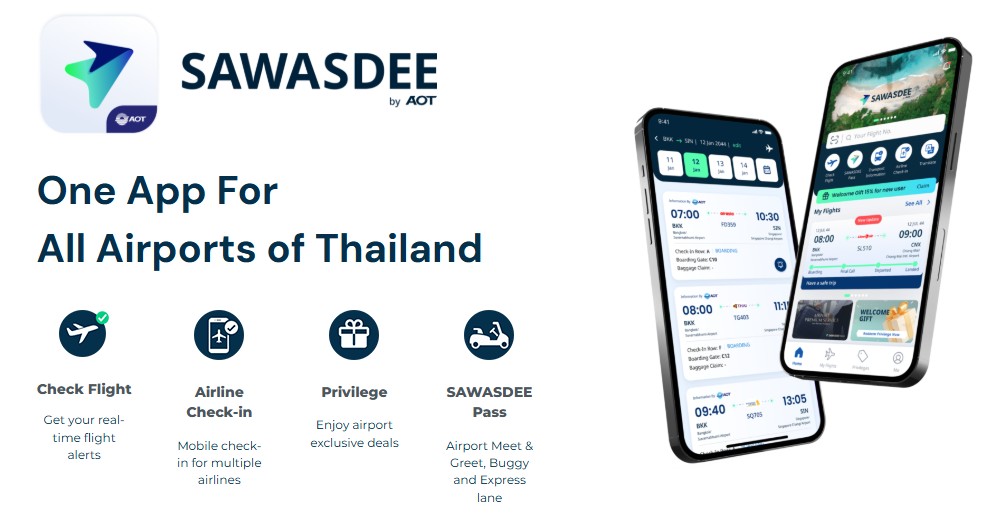
A Life Airport
AOT Digital Airport
AOT has set a strategic direction for the application of digital technology to enhance passenger convenience within its airports under the concept of a “Living Airport.”
In alignment with this vision, AOT launched its redesigned mobile application—“SAWASDEE by AOT”—in 2021, transforming the original “AOT Airports Application” into a more engaging and user-friendly platform. The application delivers a seamless and attractive airport experience for passengers, while also promoting digital transformation for commercial operators within the airport premises toward becoming a Digital Airport.
The application features a range of functions, including:

Digital Operation (M2)
AOT integrates digital technology to enhance the operational efficiency of airport management by developing a dashboard system that displays flight, passenger, and air cargo statistics on an hourly, daily, monthly, and yearly basis. The system also enables real-time analysis of flight and passenger volumes, as well as various types of vehicles. This data-driven approach supports effective resource management across both airside and landside operations, ensuring optimal allocation and utilization of airport resources.
Digital Office (M3)
AOT recognizes the importance and benefits of adapting to the digital era. We have adopted digital tools to enhance operational efficiency across our six airports, enabling our employees to perform their daily tasks with greater speed and accuracy. This systematic integration of technology helps streamline our operations and supports our journey toward becoming a fully digital enterprise.
Through this initiative, we have established a robust framework that empowers our employees to work anywhere and anytime. Key digital platforms include personal and departmental websites, a centralized organizational data storage system, digital directories, and specialized operational platforms tailored to specific job functions.
Our notable digital systems include:
Vehicle Request System: This system significantly increases speed and accuracy, reduces paper usage from physical forms, and minimizes the risk of document loss.
Meeting/Training Room Booking System: This platform provides employees with a fast, transparent, and easily verifiable way to book rooms.
These systems collectively enhance operational efficiency, optimize resource utilization, and promote eco-friendly practices, thereby supporting our commitment to sustainable business operations. Furthermore, they contribute to a modern, transparent, and socially responsible corporate image.
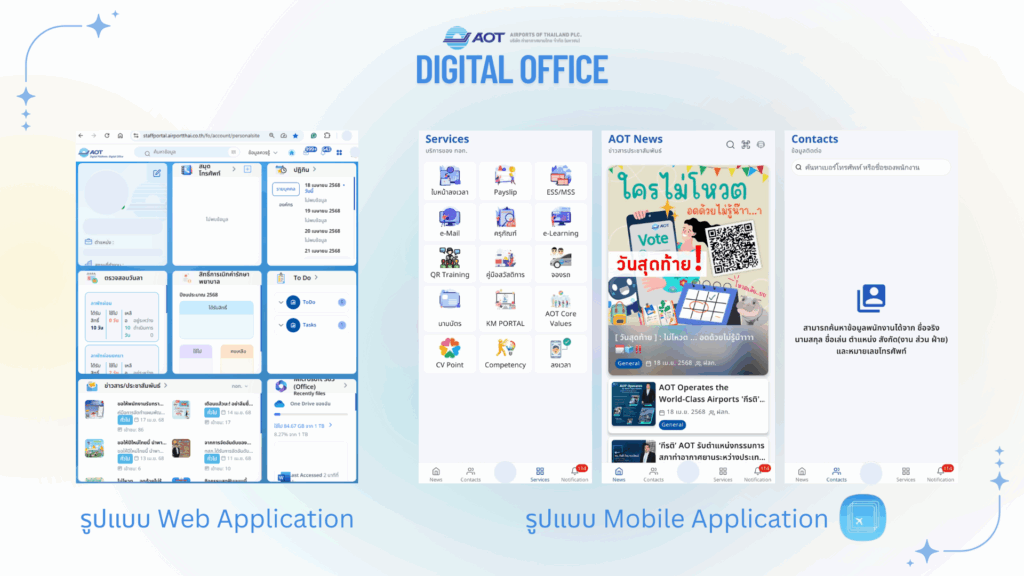
Digital Cargo (M4)
AOT recognizes the importance of developing a fast and efficient cargo transport system while addressing traffic congestion within free zone areas. To this end, the organization has developed the Digital Cargo System (M4), a digital solution for free zone management that aligns with AOT’s Smart Services strategy. The project is implemented in two phases:
Phase 1: Smart Access – Focused on facilitating visitor access through digital systems. Visitors can pre-register via the online platform (Pre-Smart) and obtain access passes independently using Self-Service Kiosks.
Phase 2: Smart Cargo – Involves the integration of information for slot management of cargo pick-up and delivery schedules through two subsystems:
- FEMS (Freezone Entry Management System): A system for managing the entry and exit of vehicles and personnel within the free zone.
- FDMS (Freezone Data Management System): A system for tracking and monitoring the movement of goods within the Suvarnabhumi Airport Free Zone.
These systems collectively contribute to congestion reduction, enhance space and traffic flow management efficiency, and support the future growth of Thailand’s air cargo operations.
Innovation
AOT’s innovation-driven transformation, as outlined in the Innovation Master Plan (2023–2027), comprises two key components: the Strategic Innovation Roadmap, which guides the organization toward becoming an innovation-led enterprise, and the Innovation Strategy, which outlines the key approaches for innovation implementation. Successfully driving this transformation requires a strong internal foundation, with organizational readiness as a critical enabler. Therefore, the strategic roadmap emphasizes investing in AOT’s human capital by cultivating innovation processes and mechanisms that build essential skills among employees—recognized as one of the organization’s most valuable resources. This foundation will support the effective execution of AOT’s four strategic innovation areas: Innovation Organization, Service Innovation, Digital Innovation, and Data-Driven Innovation. Through these strategies, AOT aims not only to achieve innovation excellence but also to drive business growth in alignment with long-term sustainability. Ultimately, the outcomes of this transformation will help position AOT as a future-ready, low-carbon organization under the vision of Innovation for Net Zero – AOT Carbon-Free.
Digital Technology and Innovation Risk Management
In integrating digital technology and innovation into airport business operations, AOT recognizes the importance of identifying and managing potential risks that may arise from such integration. This proactive approach ensures operational efficiency and compliance with established standards. AOT conducts risk assessments related to digital technology and innovation, focusing on various key risk areas, including digital data security, regulatory and compliance alignment, network security performance, system reliability, employee readiness and competency in adapting to transformation, shifting user expectations and demands, and the potential for innovation to lead to ambiguity in regulatory interpretation or activities that fall outside existing regulatory frameworks.
To address these concerns, AOT applies a structured risk management process consisting of the following steps: Risk Identification, Risk Analysis and Prioritization, Risk Assessment, and Risk Mitigation and Prevention. This comprehensive approach ensures that risks are not only understood and evaluated but also effectively managed through preventive measures and strategies to reduce their potential impact on the organization.
Implementation
Integration of Digital Technology
Sawasdee by AOT Application
In fiscal year 2024, the number of users accessing the Sawasdee by AOT application increased significantly. This growth not only reflects the success of AOT’s digital technology development in delivering value to society and users, but also enhances accessibility to AOT services in a more convenient and user-friendly manner. This improvement directly contributed to AOT’s business performance and revenue.
In FY2024, revenue generated through online channels—including the Sawasdee by AOT application and AOT’s official website—totaled THB 4,022,737.55, exceeding the organization’s original target of THB 2,400,000. This clearly demonstrates that AOT’s digital technology initiatives are effectively meeting the needs and expectations of users and stakeholders.
Digital Technology: Integrated Platform for Digital Cargo Warehouse
As part of the Digital Cargo Warehouse project aimed at enhancing transportation efficiency, AOT has developed a centralized platform to integrate and connect various internal systems with those of external stakeholders. AOT has introduced specialized modules to reduce redundancy in air cargo operations at Suvarnabhumi Airport. These modules address congestion issues, shorten processing times, and strengthen the management capabilities of goods and cargo transport vehicles. They also improve the handling capacity within the free zone area. AOT has monitored the effectiveness of this initiative through two phases: Phase 1 – Smart Access and Phase 2 – Smart Cargo.
- Phase 1: Smart Access has been completed. AOT installed self-service kiosks for issuing access cards to improve the efficiency of daily visitor entry to the cargo area. Users can now obtain entry cards directly from the kiosks by simply presenting a national ID card and a copy of the required documents. Those arriving for cargo pick-up or drop-off can conveniently generate access passes via the kiosks without delay.
- Phase 2: Smart Cargo
AOT enhanced the efficiency of cargo collection within the free zone by transitioning from an analog system to a digital system. Service users can now make advance bookings through the AOT EZ Cargo application, allowing warehouse operators (TG/BFS) to prepare goods in advance before trucks arrive for pick-up or delivery. This system helps reduce congestion in front of the warehouse areas through a Truck Queuing system, shortens the cargo handling time, and lowers overall logistics costs for users. Since the implementation of this system, the average time for cargo pick-up and delivery has decreased by 47.95%, demonstrating a significant improvement in operational efficiency.
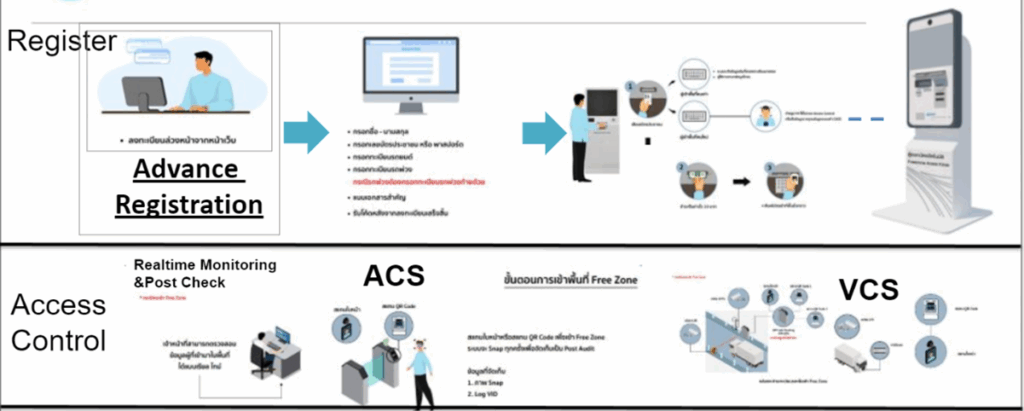
Integration of Innovation
Baggage Tracking System
The Baggage Tracking System is an innovative solution developed to enhance the efficiency and accuracy of the passenger baggage screening process. The system was officially implemented on April 25, 2023, at Phuket International Airport, with the primary objective of improving operational efficiency, reducing errors in baggage verification, and digitizing the process for greater accuracy and reliability.
This system significantly improves the screening process for baggage that fails the initial X-ray scan. It allows staff to transfer such baggage to the Baggage Inspection Room (BIR) and digitally record inspection details via an electronic platform. This approach reduces processing time and improves overall convenience for both airlines and passengers.
The system consists of three main operational steps, as follows:
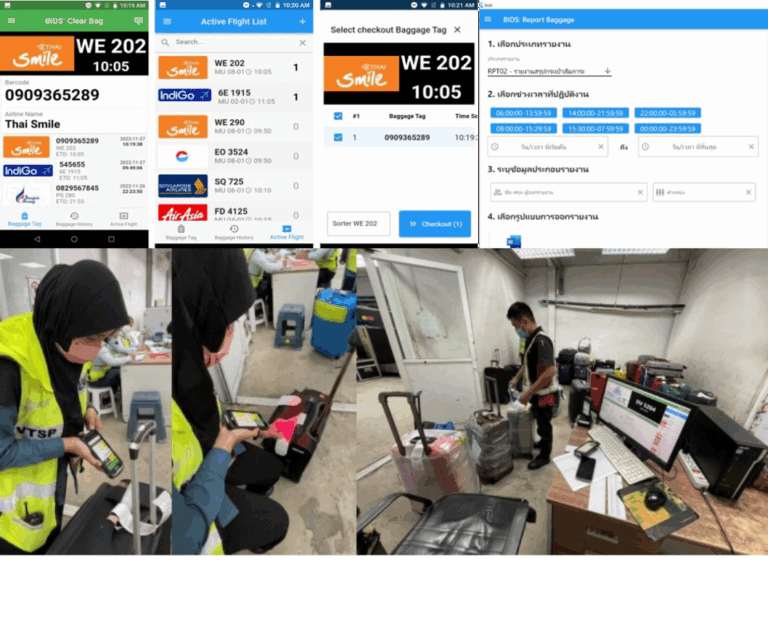
| Inspection Record | Information Transfer | Automatic Notification System |
|---|---|---|
|
|
The system provides real-time baggage status alerts, enabling staff to monitor and evaluate the situation promptly. |
In addition to enhancing the speed and efficiency of airport services, the Baggage Tracking System also generates positive impacts on society and the environment. It helps reduce resource consumption, lower greenhouse gas emissions, and improve passenger satisfaction. This system represents a significant step forward for AOT in promoting sustainable operations while supporting continued business growth.
| Social and/or Environmental Benefits | Business Benefits |
|---|---|
|
|
NOTIFLOW
NOTIFLOW is an innovative solution developed from the Development Crew – AOT Innovation Community Project, aimed at streamlining operations and reducing procedural steps. The system was officially approved for implementation on August 27, 2024, with the primary objective of transitioning work processes into a fully electronic format and achieving a paperless environment.
NOTIFLOW leverages applications currently available within AOT’s digital infrastructure—Power Apps, Power Automate, and Power BI—to support the recording, storage, processing, and visualization of data through advanced data analytics. It also integrates real-time notifications via the LINE application, replacing traditional paper-based reporting, which has long been limited by extensive paper usage and manual handling.
| Social and/or Environmental Benefits | Business Benefits |
|---|---|
|
|
Note: This summary presents the operational results of the Airside Operations Department at Phuket International Airport, which serves as the pilot unit for this initiative. In the future, the project is expected to be expanded and further developed into a broader initiative that applies digital technology systems to enhance airside operations.
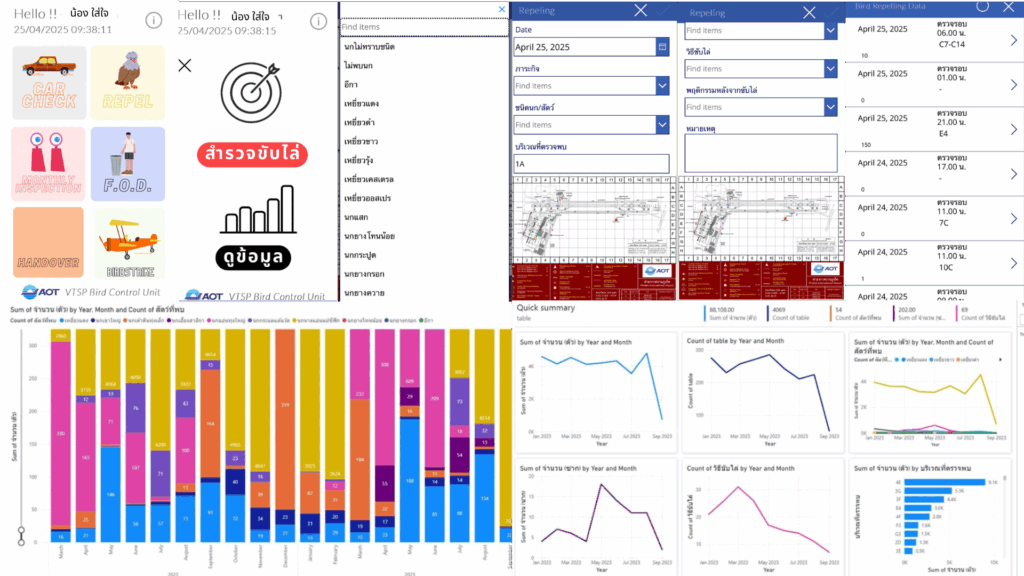
Automated Biometric Identification System: Biometric
In 2024, AOT continued to advance its innovation initiatives in support of climate change mitigation by eliminating paper usage and fully transitioning to electronic systems. One of the key projects under this initiative is the implementation of the Automated Biometric Identification System, which utilizes Facial Recognition Technology for passenger identification.
This system has been deployed to enhance convenience and reduce queueing time for passengers at various service points. By improving travel efficiency and streamlining processes, the biometric system elevates the overall passenger experience. It has been rolled out across all six AOT-operated airports, with domestic passenger services launching on 1 November 2024, followed by international passenger services on 1 December 2024.
Following the implementation, Suvarnabhumi Airport recorded an increase in its Airport Service Quality (ASQ) score, attributed to the reduction in service steps and overall waiting times. The average waiting time decreased by 10%, equivalent to approximately 37 minutes. In the first quarter of 2025 (January–March 2025), Suvarnabhumi’s ASQ score reached 4.23 out of 5, an improvement of 0.15 points compared to the same period in 2024, prior to the Biometric system implementation.
In addition to improving service efficiency, the Biometric system has significantly contributed to paper reduction during the check-in process for both passengers and airlines. It is estimated that more than 70 million sheets of paper will be eliminated in 2025 across AOT’s six airports—based on the average passenger volume from 2020 to 2024, with one sheet per passenger.
In addition, AOT’s adoption of advanced digital technologies to enhance passenger facilities has led to a significant improvement in service quality. Most notably, Skytrax, the globally recognized airport ranking platform, announced its list of the World’s Best Airports 2025, in which Suvarnabhumi Airport (BKK) ranked 39th, a remarkable rise of 19 positions from the previous year’s 58th. Suvarnabhumi was also named the 3rd World’s Most Improved Airport in 2025, and ranked 6th in the Best Airports handling 50–60 million passengers per year.
Meanwhile, Don Mueang International Airport (DMK) was ranked 8th in the World’s Best Low-Cost Airline Terminals, up from 10th place the previous year.
These rankings are based on the World Airport Survey, conducted by Skytrax, a leading UK-based aviation research and consultancy firm specializing in global airline and airport service quality assessments. The results were officially announced on 9 April 2025 during the Passenger Terminal Expo 2025, held in Madrid, Spain.
The significant rise in rankings for both Suvarnabhumi and Don Mueang Airports reflects AOT’s continuous improvements in infrastructure, technology, and service quality, aimed at elevating the standards of Thailand’s airports to meet global benchmarks and exceed passenger expectations—bringing pride to the Thai people as a whole.
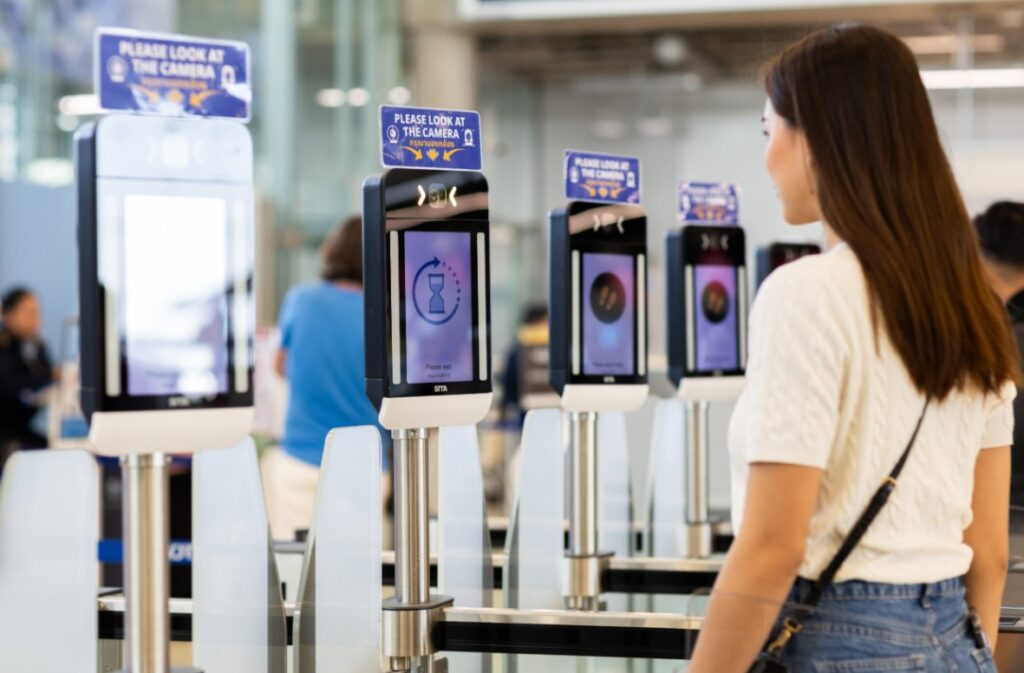
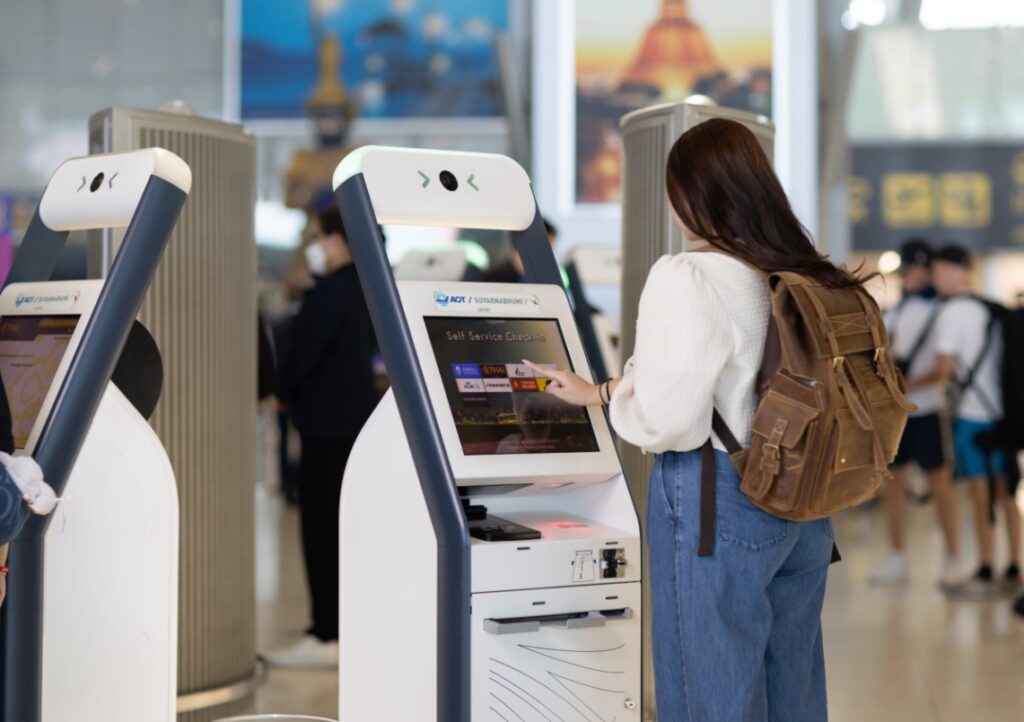
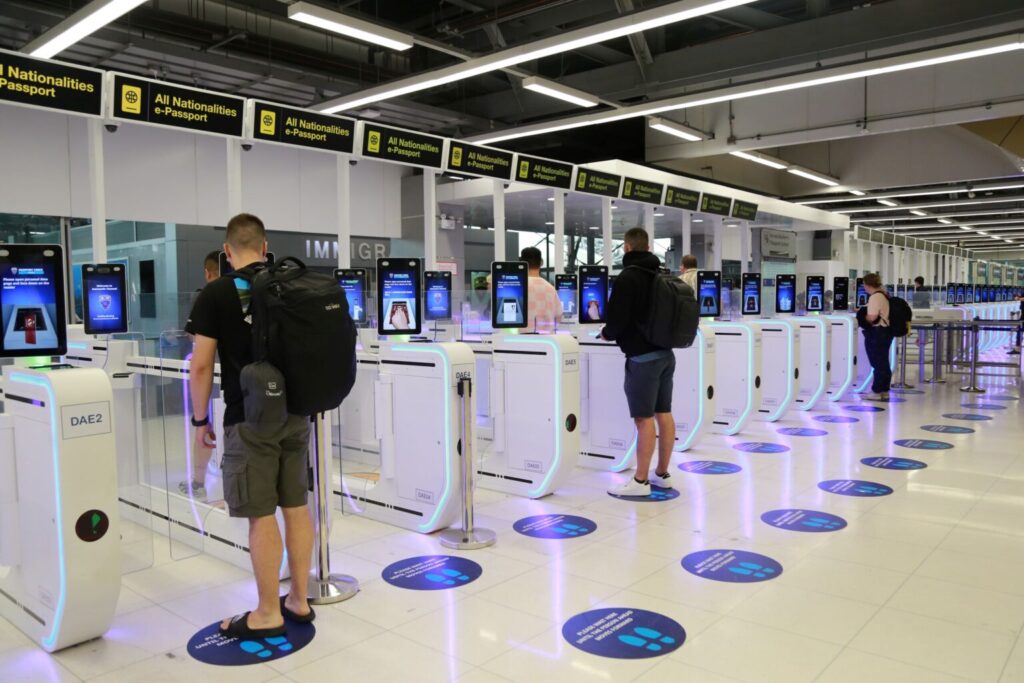
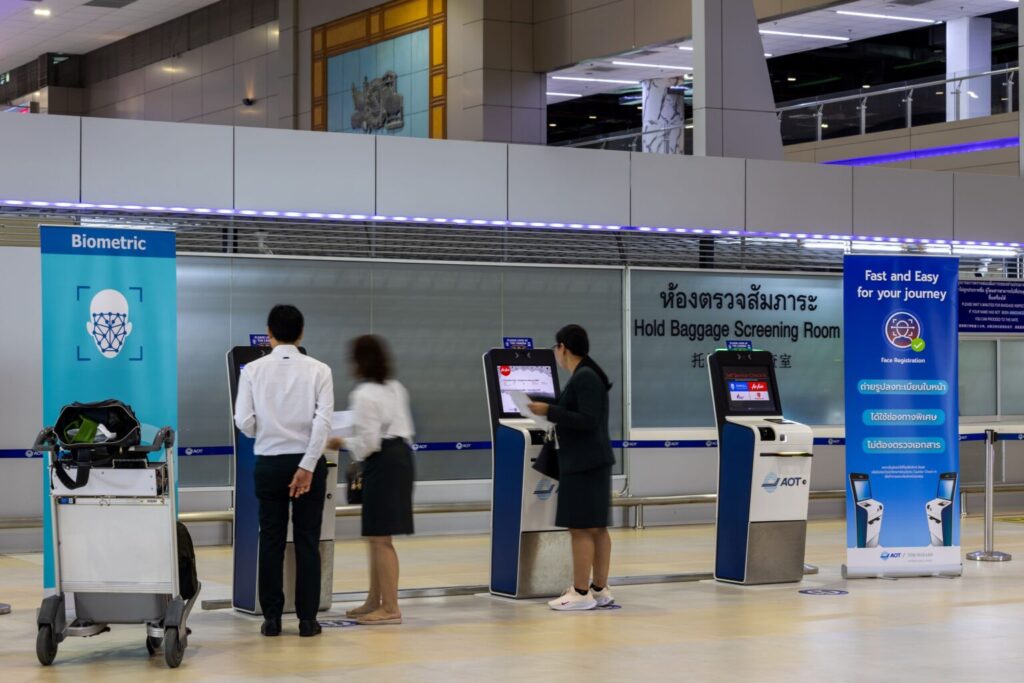
Source: www.airportthai.co.th/
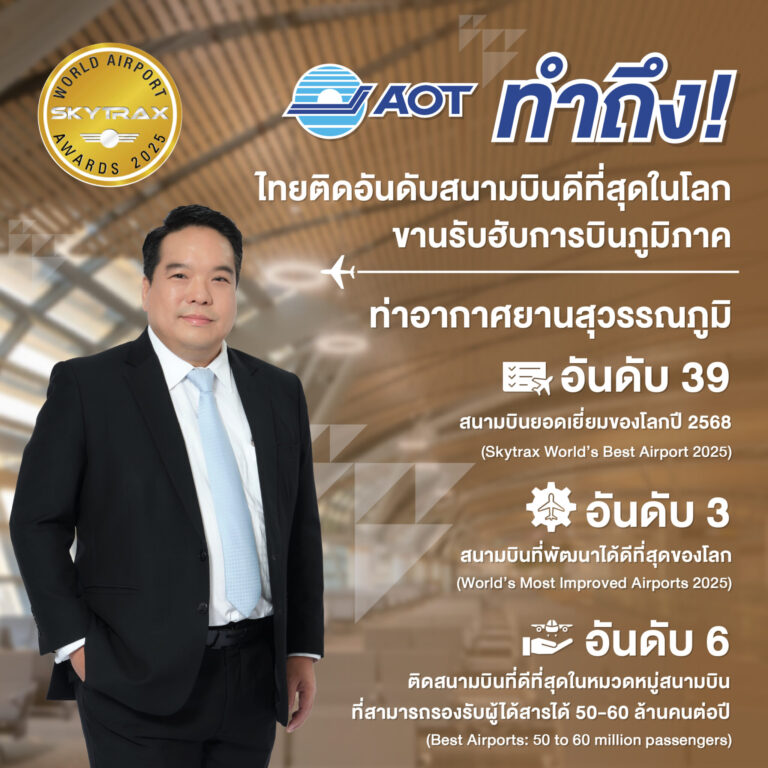

AOT Face Scan on Mobile
AOT has implemented digital technologies to enhance its organizational management systems under the M3 Digital Office initiative, as part of the ERP-SAP (Enterprise Resource Planning) platform. This aims to optimize internal resource management by integrating various internal and external information systems to ensure maximum efficiency and utility.
In fiscal year 2024 (B.E. 2567), AOT developed a modern employee time management system called AOT FaceVerify, which enables employees to clock in and out by scanning their faces using their personal mobile devices. The system is powered by AI facial recognition technology and utilizes Bluetooth Low Energy (Beacon) devices to determine user locations. The system has been operational since 12 July 2024 at AOT Headquarters, Suvarnabhumi Airport, and Don Mueang Airport. The project is currently in the process of being expanded to cover all regional airports under AOT’s management.
| Social and/or Environmental Benefits | Quantitative Business Benefits |
|---|---|
|
|
Fostering Organizational Culture Toward the Digital Era
Development Crew Project
The Development Crew Project focuses on transforming creative ideas into prototype innovations by providing financial and technological support from relevant departments. The initiative selects ideas that align with the organization’s strategies and deliver value to AOT. In 2024, the committee approved the development of three innovation projects following the innovation development process—from the development stage to actual implementation—as follows:
- Pick and Pack (AOT iCheck): A mobile application that allows passengers to verify whether their belongings can be carried onboard. It also serves as a database for inspection and public relations staff to assist passengers with the baggage screening process.
- NOTIFLOW: A digital reporting system for operations in airside areas, including report creation and performance visualization, aimed at transitioning work processes to a fully electronic format.
- AOTDP (AOT Digital Platform): A system designed to support the process of requesting permission for the registration and use of state property land.
Think Out Loud
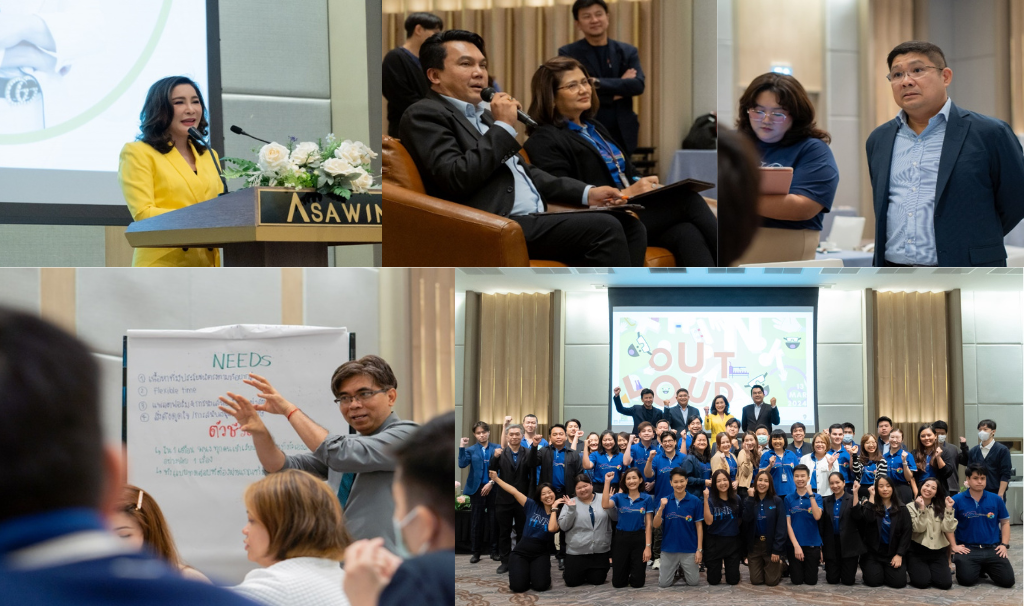
AOT encourages both its personnel and external stakeholders to collaboratively analyze and brainstorm innovative ideas through an Open Innovation approach. This initiative focuses on solving current operational and service-related challenges while fostering collaborative networks that lead to the development of innovations that effectively respond to societal needs.
Innolution

This initiative is an innovation idea contest that invites both internal personnel and external stakeholders to present creative concepts with the potential to be developed into practical innovations. It also aims to build collaborative networks for the development, improvement, and enhancement of AOT’s management and service delivery.
AOT Innovation Day
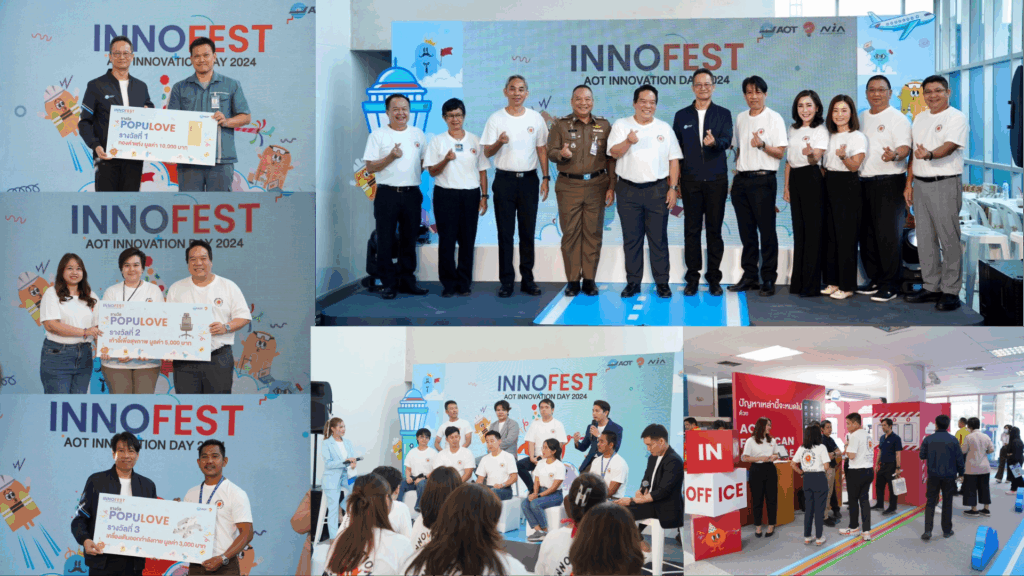
This annual AOT event showcases operational outcomes and innovation projects developed by both internal and external personnel. It also serves to promote innovation awareness and foster a culture of innovation across the organization by creating an environment that encourages creativity, recognition, and the exchange of ideas with innovators and external experts.
Think Out Loud Project under AOT Open Innovation: Hackathon
Airports of Thailand (AOT), in collaboration with academic institutions—Thammasat University, Kasetsart University, and the Civil Aviation Training Center—organized the “Think Out Loud” project to foster creative and innovative ideas. The Innovation Strategy Department reviewed and selected the most promising ideas for further development under AOT’s innovation process. Five innovative concepts were selected as follows:
- Chu Chu Space: Installation of co-working space pods to enhance privacy and help reduce passenger congestion within terminals. Passengers can reserve and pay for use via a digital system.
- Fast & Feel Goods: A pre-ordering and reservation system for food and beverages using a QR code printed on the boarding pass.
- Seamless Airport by AOT: Development of a digital system for parking reservation (Digital Parking Queue), fast-track lanes (Fast Lane), and duty-free e-commerce services.
- SMS Connecting More People: Utilizing SMS to provide passengers with useful travel information and promotional marketing messages upon arrival at the airport.
- Flight with the Flow: Utilizing empty spaces in the Service Hall to create a marketplace for products and services under the concept of a “Floating Market.” This initiative aims to support social enterprise and create new income opportunities for local OTOP vendors and surrounding communities at Don Mueang Airport. It also serves to enhance space utilization while offering unique cultural experiences to tourists.
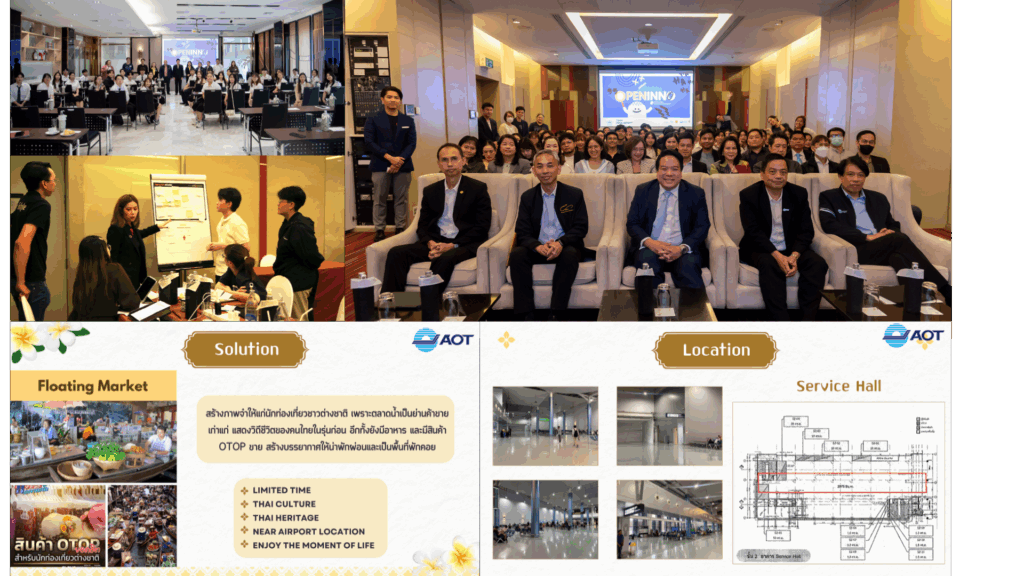
Lessons Learned
From the implementation of projects under AOT’s Innovation Master Plan, it was found that the main challenges lie in cross-departmental coordination and the adoption of new tools or technologies, where there is often a lack of sufficient expertise and support. Additionally, fostering a shared understanding of the concept of sustainable innovation still requires clear and continuous communication.
Application of Lessons Learned in Policy and Operational Processes
In fiscal year 2025, AOT has planned innovation-related initiatives under the AOT Innovation Master Plan for FY2023–FY2027 (Revised Edition for FY2024), namely the “Think Out Loud: Sustainable – Innovation for Sustainability and the Environment” project. The project includes the following activities and objectives:
- Organizing additional training sessions for staff in relevant departments to enhance their skills in using innovation tools and technologies related to sustainability
- Developing integrated cross-departmental collaboration mechanisms through the creation of an effective communication platform to support information exchange and cooperation
- Establishing clear standard operating procedures for sustainability-focused innovation projects
Expected Outcomes
These improvements aim to enhance the effectiveness of innovation projects, particularly in fostering cross-functional collaboration, and achieving the goals under Strategic Objective 4 (SO4): Lead Changes Toward Sustainability, which focuses on developing environmentally friendly and sustainable airports.
